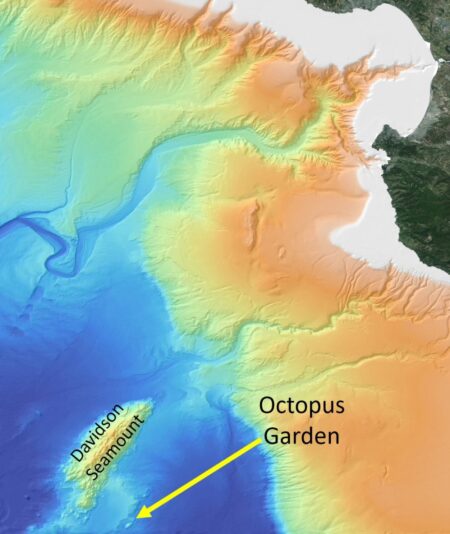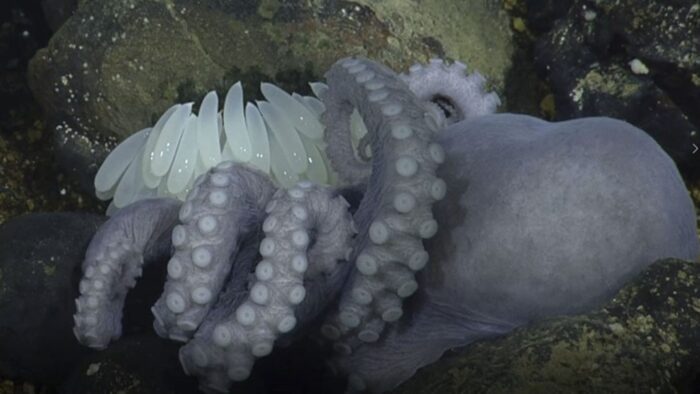The Davidson Seamount is one of the largest underwater mountains in the world. It is also a favourite spot for thousands of octopuses.
And now we think we know why. They love the warmth!
This answer makes sense once you learn that Davidson Seamount is actually an underwater volcano. It is found off the coast of California and is about 42 km (26 miles) long and 13 km (8 miles) wide. Though it is 2,280 m (7,480 ft) tall, its peak is still 1,250 m (4,101 ft) below the surface.
This means that the entire seamount is in constant darkness—sunlight does not penetrate any deeper than about 1,000 metres (3,280 ft). And yet, it and the area around it are full of life!
Thousands of them!

This underwater map shows the locations of Davidson Seamount and the so-called Octopus Garden. Higher underwater ground is in orange, while the deepest areas are in blue. (MBARI)
Researchers first learned about the connection between the pearl octopus (Muusoctopus robustus) and Davidson Seamount on a deep sea dive back in 2018.
A team from the Monterey Bay Aquarium Research Institute (MBARI) found that thousands of these animals were using a place near the seamount's base as a nursery (this is a place where animals mate and lay eggs). There were so many that it became known as the Octopus Garden. But as stunning as the find was, scientists were a bit confused.
The location of the Octopus Garden was 3,200 m (10,500 ft) deep. The average temperature here is a very chilly 1.6 degrees Celsius (35 Fahrenheit). That is really cold, especially when octopus are cold-blooded animals.
Why were the octopuses choosing this spot to raise their young? Why in the deep dark sea where temperatures are barely above freezing?
Heat sources

This close-up image shows the eggs that this mother is guarding. Even in this warmer area, the eggs incubate (or develop) for about 21 months. That's nearly two full years! (MBARI)
To solve the mystery, researchers from MBARI went back to investigate. They conducted 14 dives over three years, gathering lots of new data. What they found was that the octopuses were clustering together in particular crevices that were hydrothermal springs.
These are areas where heat from inside the volcano seeps up into the water. Though the temperature was not exactly hot—just 11 degrees C (52 F)—it is enough to make a difference. The warmth improved how quickly the octopus eggs devloped.
According to James Barry of MBARI, "by nesting at hydrothermal springs, octopus moms give their offspring a leg up." Nice work, mommies!
Check out a tour of the Octopus Garden in the MBARI video below!
 Look at them all! Dozens of pearl octopuses can be seen in this image. (MBARI)
Look at them all! Dozens of pearl octopuses can be seen in this image. (MBARI)








